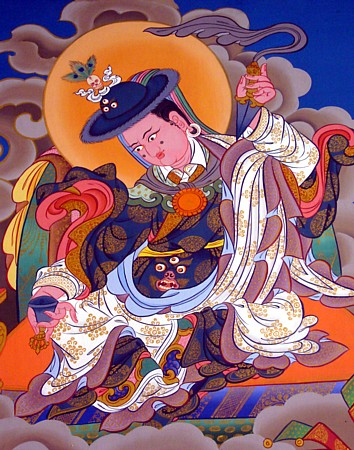Düpa Do: Difference between revisions
Jump to navigation
Jump to search
mNo edit summary |
No edit summary |
||
| Line 1: | Line 1: | ||
[[Image:Sangye Yeshe.jpg|frame|[[Nupchen Sangyé Yeshé]]]]'''Düpa Do''' ([[Wyl.]] ''‘dus pa mdo'') or the '''Do Gongpa Düpa''' (Wyl. ''mdo dgongs pa ‘dus pa''), ''The Sutra which Gathers All Intentions'' — the principal text of the [[Anuyoga]]. It was translated from the language of Gilgit by Chetsun Kyé, a native of Gilgit, in the late 8th or early 9th century. The Anuyoga tantras were brought to Tibet by [[Nupchen Sangye Yeshe]]. | [[Image:Sangye Yeshe.jpg|frame|[[Nupchen Sangyé Yeshé]]]]'''Düpa Do''' ([[Wyl.]] ''‘dus pa mdo'') or the '''Do Gongpa Düpa''' (Wyl. ''mdo dgongs pa ‘dus pa''), ''The Sutra which Gathers All Intentions'' — the principal text of the [[Anuyoga]]. It consists of 75 chapters and was translated from the language of Gilgit by Chetsun Kyé, a native of Gilgit, in the late 8th or early 9th century. The Anuyoga tantras were brought to Tibet by [[Nupchen Sangye Yeshe]]. | ||
==Commentaries== | ==Commentaries== | ||
Revision as of 20:39, 10 October 2011

Düpa Do (Wyl. ‘dus pa mdo) or the Do Gongpa Düpa (Wyl. mdo dgongs pa ‘dus pa), The Sutra which Gathers All Intentions — the principal text of the Anuyoga. It consists of 75 chapters and was translated from the language of Gilgit by Chetsun Kyé, a native of Gilgit, in the late 8th or early 9th century. The Anuyoga tantras were brought to Tibet by Nupchen Sangye Yeshe.
Commentaries
- Katok Dampa Deshek (1122-1192) wrote several commentaries
- Rigdzin Pema Trinlé (1641-1717) wrote an explanation of the empowerments of Düpa Do at the request of the Great Fifth Dalai Lama.
- Lochen Dharmashri (1654-1717) wrote a ‘dus pa mdo skor gyi yig cha.
- Jikmé Lingpa (1729-1798) wrote a dgongs ‘dus rnam bshad.
- Khenpo Nüden wrote a dgongs ‘dus ‘grel chen.
- Khenpo Ngakchung wrote a ‘dus pa mdo’i bsnyen yig.
Further Reading
- Dudjom Rinpoche, The Nyingma School of Tibetan Buddhism, Its Fundamentals and History, trans. and ed. Gyurme Dorje (Boston: Wisdom Publications, 1991), the story of the transmission of this text is given throughout History (Book Two), Part Five; also read Part Seven, 'Ch. 3 Response to Critics of the Sutra which Gathers All Intentions'.
- Jacob Dalton, The Uses of the dGongs pa 'dus pa'i mdo in the Development of the rNying-ma School of Tibetan Buddhism, University of Michigan, 2002